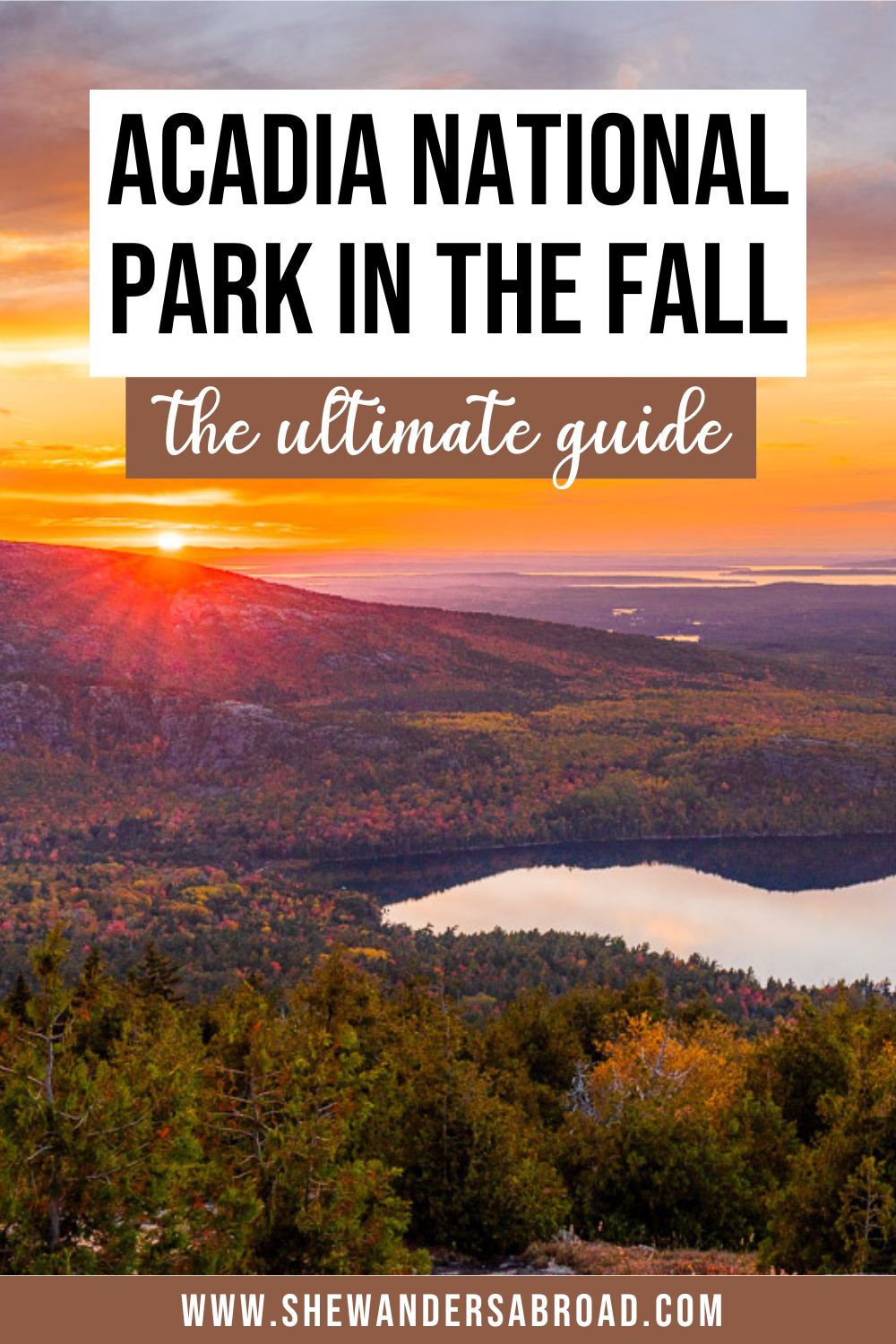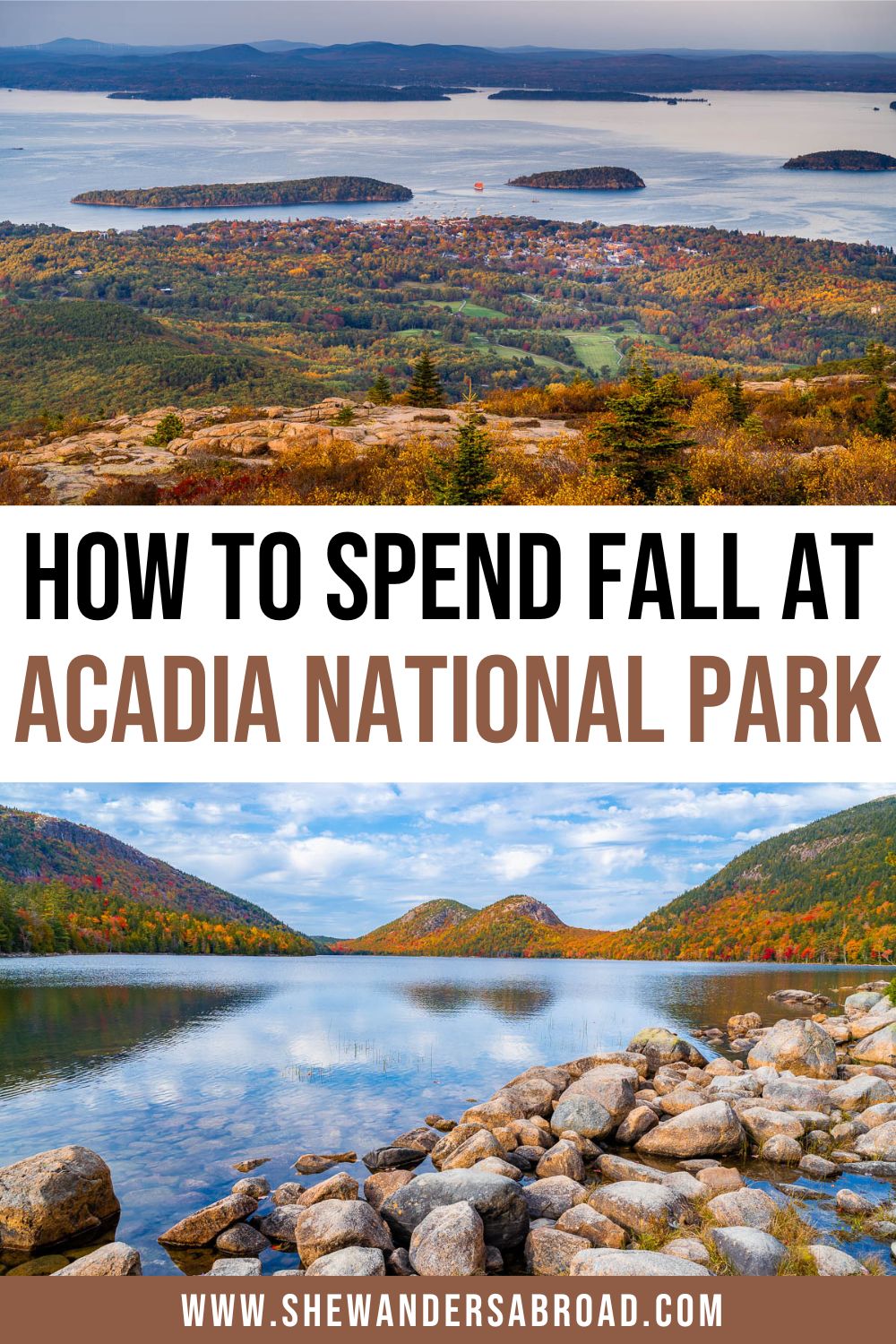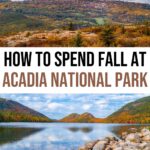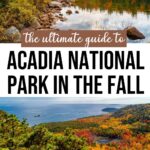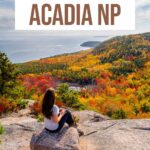Acadia National Park is a true gem on the East Coast of the US. Although it’s stunning at any time of the year, Acadia in the fall is something special.
Undoubtedly the pride and joy of Maine, Acadia is considered New England’s only national park. As a result, millions of visitors flock to the park every year, with the summer season of June to August seeing the largest crowds.
However, if you really want to see the towering trees, rugged landscapes, and majestic mountains in all their glory, time your visit to catch the fall colors in Acadia National Park in September and October.
Fall in Acadia is a magical experience, and this post will give you the low down on everything you’ll need to know for planning a visit, from what kind of weather to expect to packing tips.
*Disclosure: This post contains a few affiliate links, which means I may receive a small commission, at no cost to you, if you make a purchase through my link.*
Table of Contents
Why Visit Acadia National Park in the Fall?
Nothing beats visiting Acadia National Park in the fall. It’s like nothing you’ve ever seen, between the favorable weather and incredible fall-colored leaves.
As October rolls in, the Acadia National Park fall foliage is in full swing, and the park is a gorgeous mix of brightly colored leaves that make for some incredible vistas. Thanks to the park’s oceanside location and plentiful supply of lakes, the colorful foliage stands out against the blue waters.
Another advantage of heading to Acadia National Park from mid-September until late October is the reduced footfall. You can savor the more peaceful hiking trails, avoid the frustrating process of finding a parking space, and avail yourself of slightly cheaper accommodation costs.
While you can’t expect to have the place to yourself, planning your trip after Labor Day Weekend ensures you can skip the worst of the crowds.
Another bonus of a fall visit is the weather. Acadia generally doesn’t get too hot in the summer, but the winter months see temperatures plummet to below freezing.
Fall temperatures are perfect for hiking as the colder weather has yet to kick in, and the warmer months have passed, making tackling the many trekking trails much more manageable and pleasant.
Pathways are usually easy to pass in the fall, too, as the summer sun has dried up much of the mud from the snow and rain in winter and early spring.
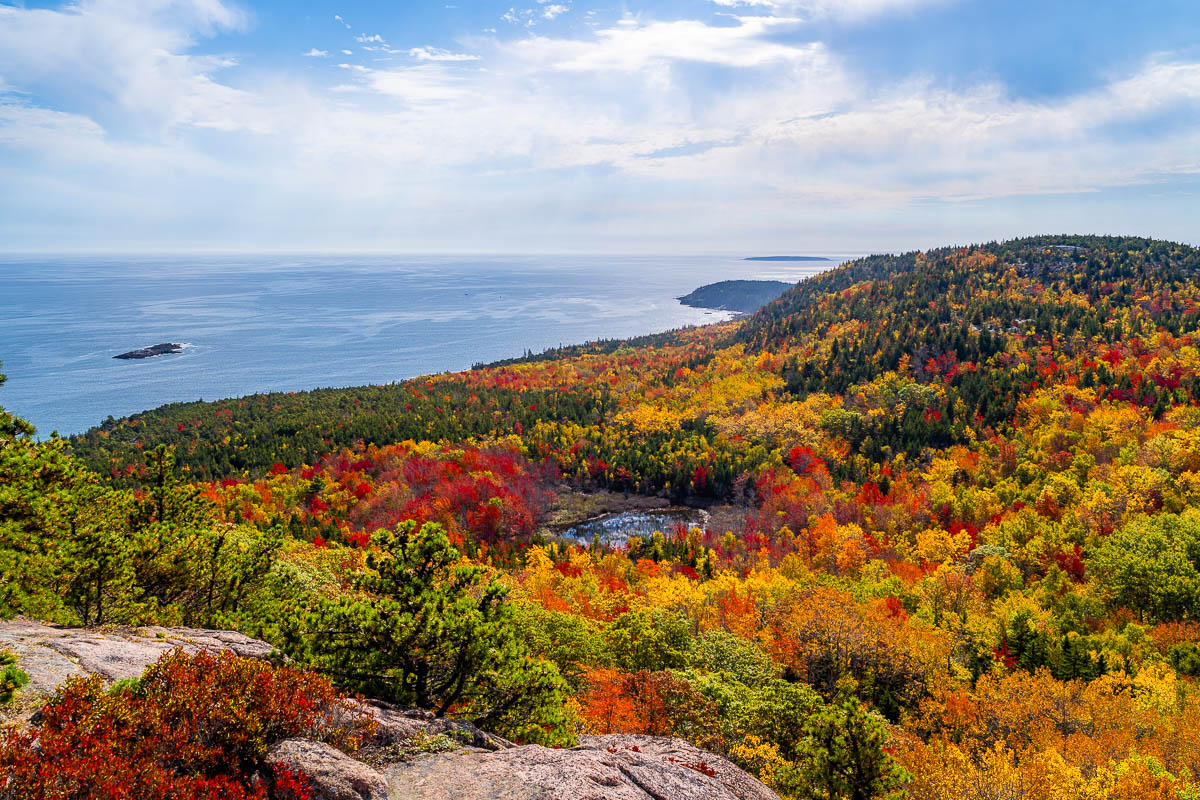
Best Time to Visit Acadia National Park for Fall Foliage
The birch, maple, and poplar trees that make up much of Acadia National Park start to change color and transform into all shades of red, orange, yellow, and brown from around mid-September.
They continue to get increasingly vivid and even more beautiful as the weeks progress, with peak fall foliage generally happening around mid-October.
From this time up until the end of October, the park is alive with warm colors that make the landscapes even more captivating.
Naturally, crowds tend to pick up again during the last two weeks of October, so slightly earlier in the month can be a great time to catch the trees right before they peak. Acadia will still be just as lovely but a little more tranquil. It’s a win-win!
Of course, weather can play a huge role in how the fall colors progress, so if you want to make sure you time your visit right, keep your eyes on the peak fall foliage map. Regardless of the time you decide to visit, Acadia National Park simply has to feature on your New England fall road trip itinerary!
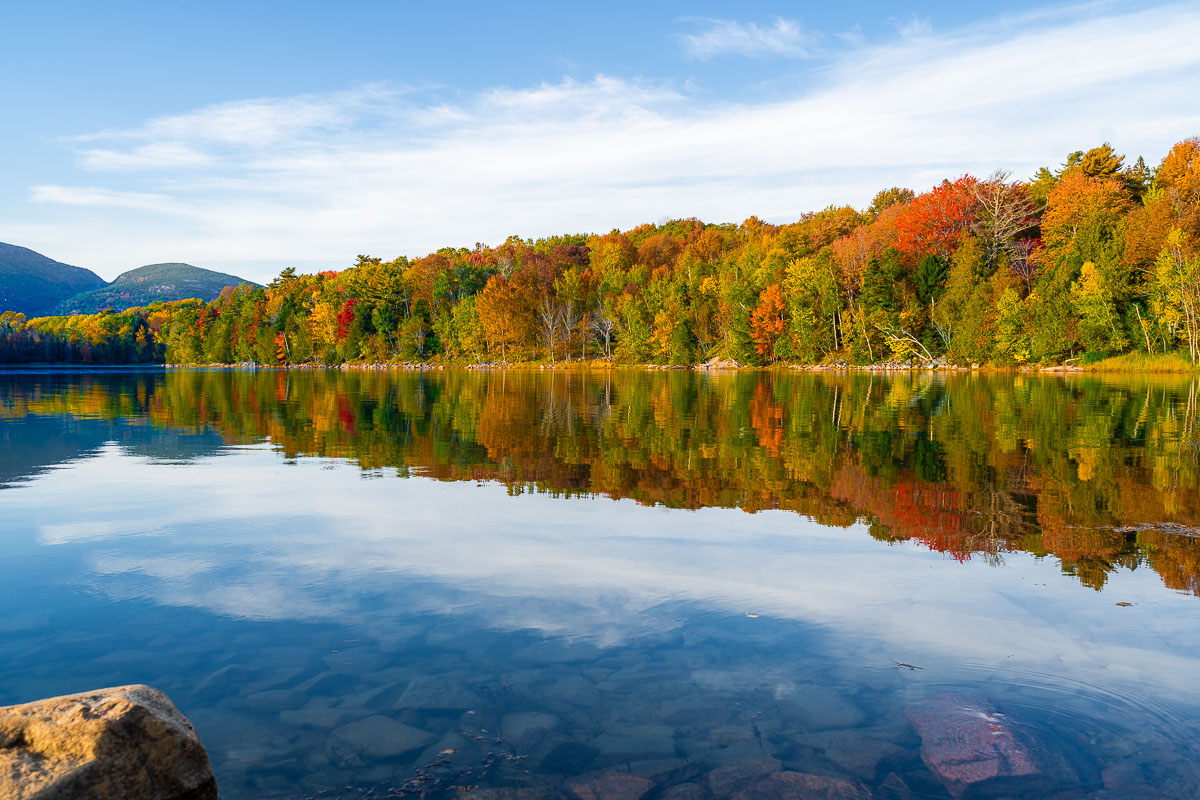
Useful Information for Visiting Acadia National Park in October
How to get to Acadia National Park
Hancock County-Bar Harbor Airport is conveniently located just a 20-minute drive from Acadia National Park. Visitors from further afield may need to fly into Logan International Airport in Boston before connecting to Hancock County.
Flights to this small airport can be pretty expensive, so it’s also worth considering driving from Logan Airport, about a 4.5-hour drive from Acadia National Park or Portland International Jetport, which should take around 3 hours.
For anyone planning to drive to Acadia in the fall from Boston, you’ll make your way to Mount Desert Island, the home of most of Acadia National Park, via Interstate 95. Head towards Bangor and exit for Bar Harbor, the gateway town on Mount Desert Island to the park.
Are you flying into or starting your journey from Portland, Maine? If so, Highway 1 will take you all along the coastline, passing by cute seaside towns and historical lighthouses to keep you entertained.
Once you arrive at a town called Ellsworth, you’ll need to switch to Highway 3 to continue your journey to Mount Desert Island.
Highway 1 is undoubtedly the more picturesque route, but you don’t have to miss out if you’re coming from Boston. Extend your journey a little and change onto Highway 1 from Interstate 95 once you reach Portland to take in the views and sights.
When you get to the island, you’ll likely start your explorations from Bar Harbor, which is just a few minutes from the entry points and visitor centers.
If you have some extra time, make sure to spend a day in Portland ME, or at least quickly visit some of the best lighthouses in Portland!
If you’re coming from Boston, you can also spend one day in Boston to discover the highlights of the city.
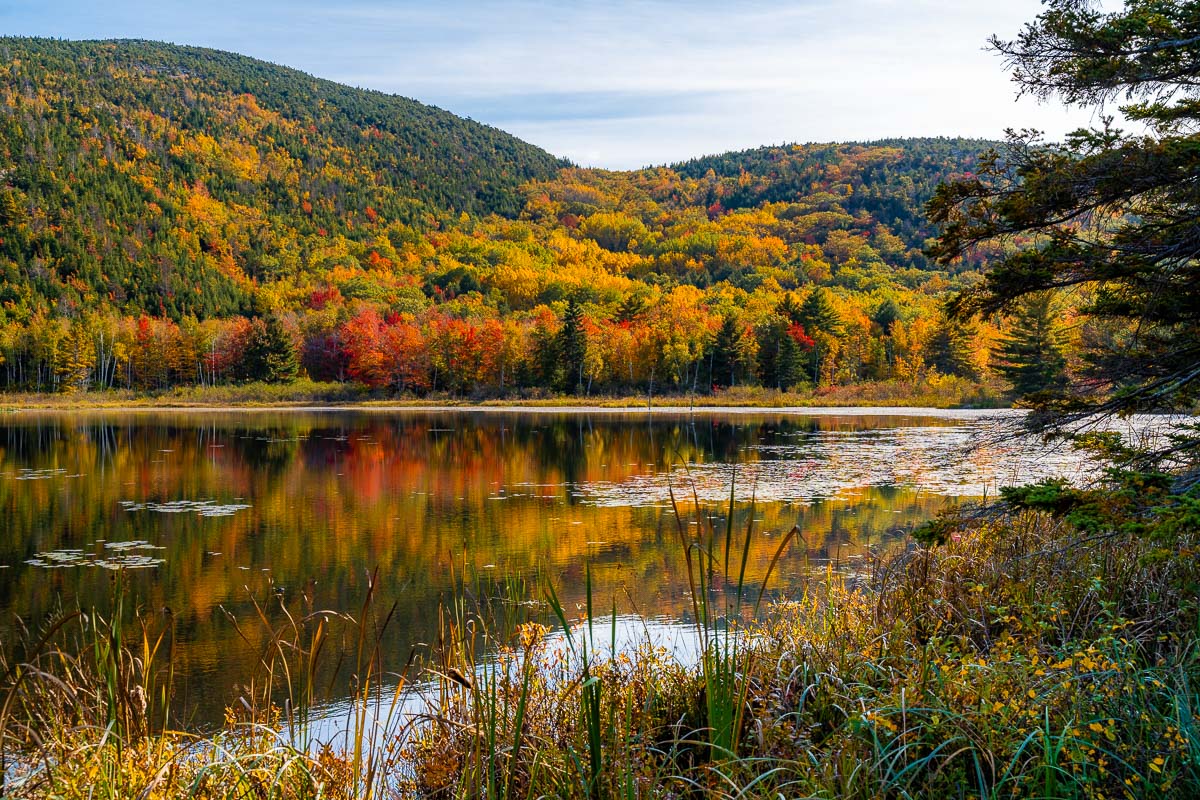
Entrance fees to Acadia National Park
If you’re traveling to Acadia National Park in the fall or any other time of year, you must purchase a park entrance pass.
The price of the passes varies depending on how you enter, and each of the following permits is valid for seven days, excluding the annual pass.
Let’s take a look at what each pass entails:
- Private vehicle: At $35 per vehicle, cars, vans, and RVs with less than 16 people can avail of this pass, and no additional tickets are needed for passengers. This excludes commercial vehicles.
- Motorcycle: One or two passengers can enter on this pass for $30.
- Person: Anyone entering on foot or by bicycle must pay for a $20 pass.
- Non-commercial vehicles with 16+ passengers: For larger vehicles carrying over 16 people, each person must purchase a $20 pass.
- Annual pass: For anyone considering making a few visits to Acadia, there’s a yearly pass for $70, covering the fees for the pass holder and the other passengers in the vehicle.
Insider tip: If you’re planning to visit more national parks, make sure to take a look at the Annual America the Beautiful Pass. The pass costs $80, and it gives you access to more than 2,000 federal recreation sites, including national parks, for 12 months.
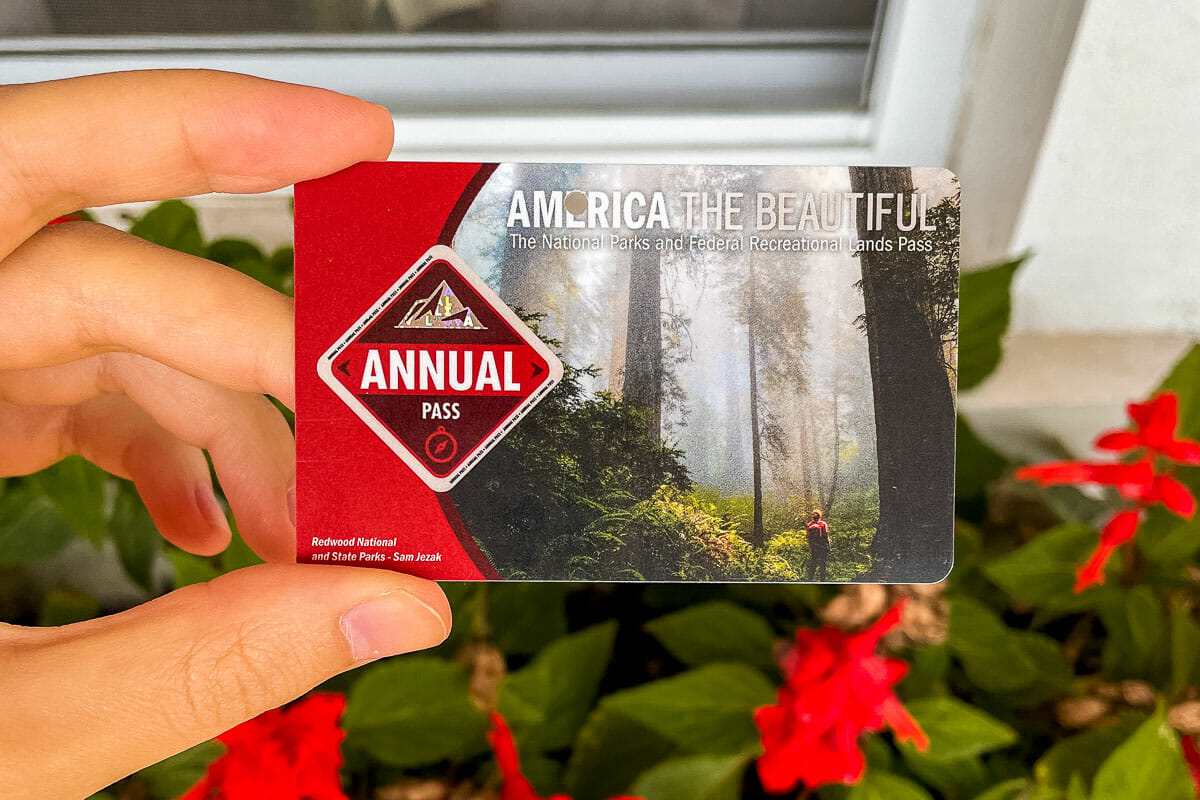
You also have a few options for how to buy your pass for Acadia National Park:
- Online: I definitely recommend securing your pass on the Recreation.gov website or app in advance. Print it off, place it on your dashboard, and start your adventure hassle-free.
- Automated fee machines: If you plan to arrive near the Hulls Cove Visitor Center or the Schoodic Institute at the Schoodic Peninsula, you can use the automated machines to purchase a vehicle, motorcycle, or individual pass via credit card.
- In-person: The following locations sell a wide range of passes that you can buy in-person via cash or card: Hulls Cove Visitor Center, Schoodic Woods Campground, Blackwoods Campground, and Seawall Campground.
Here are a couple of other things to keep in mind:
- Passes are non-transferable, and the holder must be present to be valid.
- Under 15s can visit for free if they arrive on foot, by bicycle, or as part of a group with more than 16 people.
- After you’ve purchased your pass, be sure to keep it visible from the windshield.
- Every year, there are usually a few fee-free days. Some of these days in for 2023 include National Public Lands Day on September 23rd and Veterans Day on November 11th.
- The road to the summit of Cadillac Mountain requires a separate fee and reservation if you’re traveling in a private vehicle between the end of May and late October, costing $6. Reservations must be made in advance online on the Recreation.gov website, as they are not available at the park.
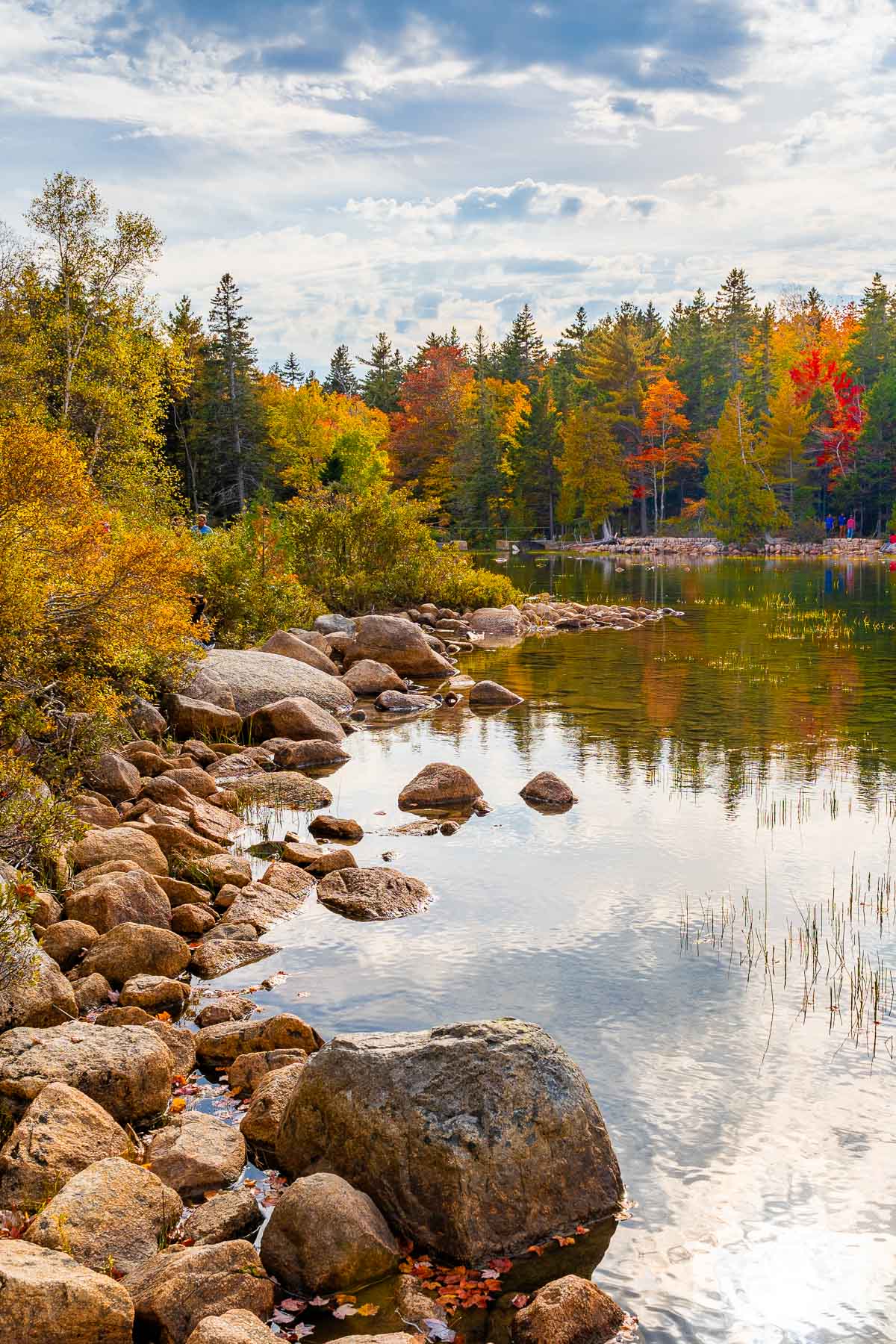
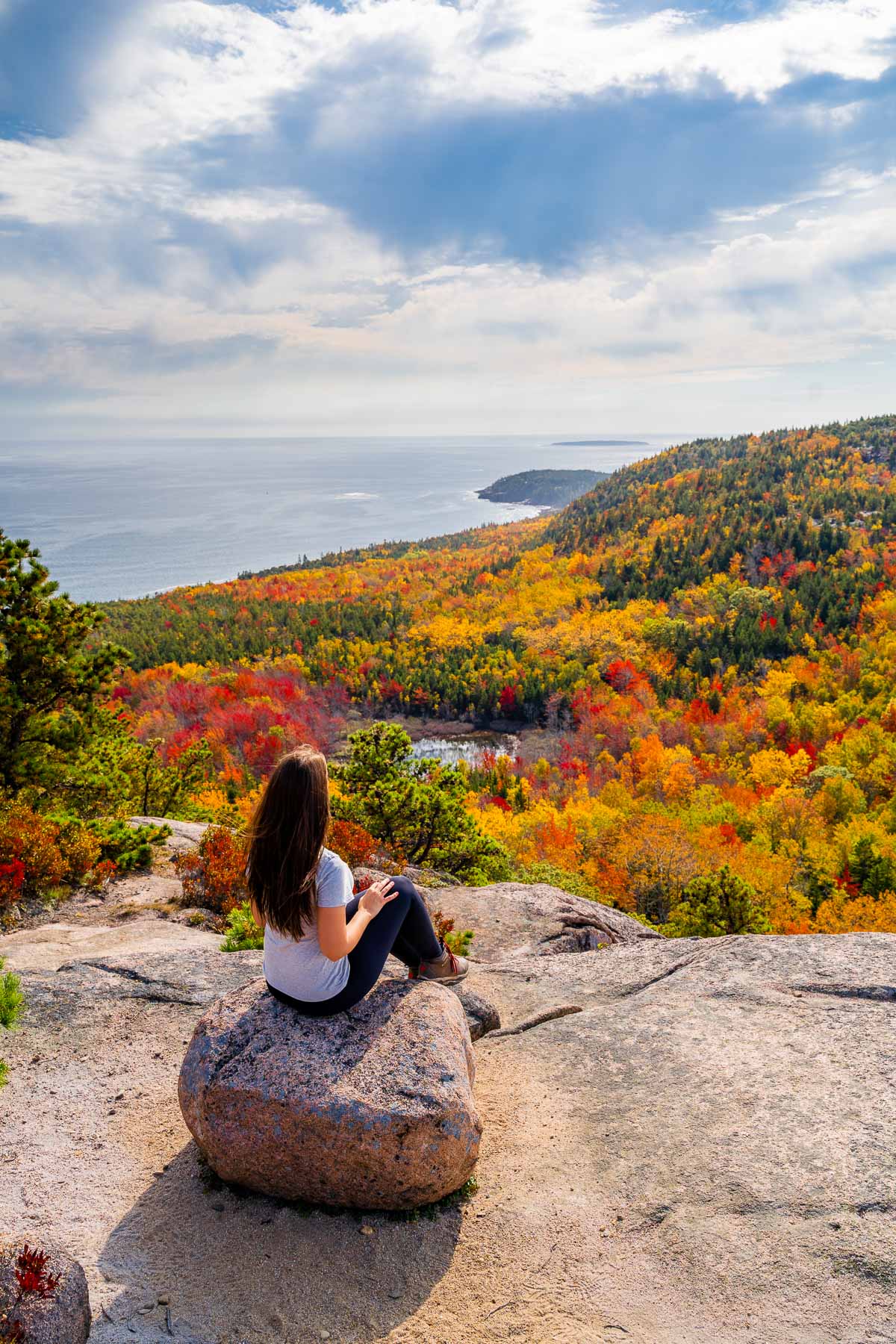
How to get around Acadia National Park
Acadia National Park in the fall is very accessible, and you can choose to explore the area on foot, by shuttle bus, or from the comfort of your car. Depending on where you want to visit, a combination of these may suit your needs.
How to get around Acadia on foot
Hikers will love exploring the park on foot, with over 120 miles (193 km) of incredible trails in addition to the 45 miles (72.5 km) of car-free carriage roads.
Don’t worry if you’re not an avid trekker, as Acadia has plenty of easy and moderate routes that are enjoyable and feasible for different fitness levels. On the other hand, if you’re keen to tackle some challenging trails and steep climbs, Acadia has plenty of those, too!
Each path is filled with gorgeous scenery and picture-perfect views, so you can’t go too far wrong, but we’ll get into more detail about what hikes you can do later.
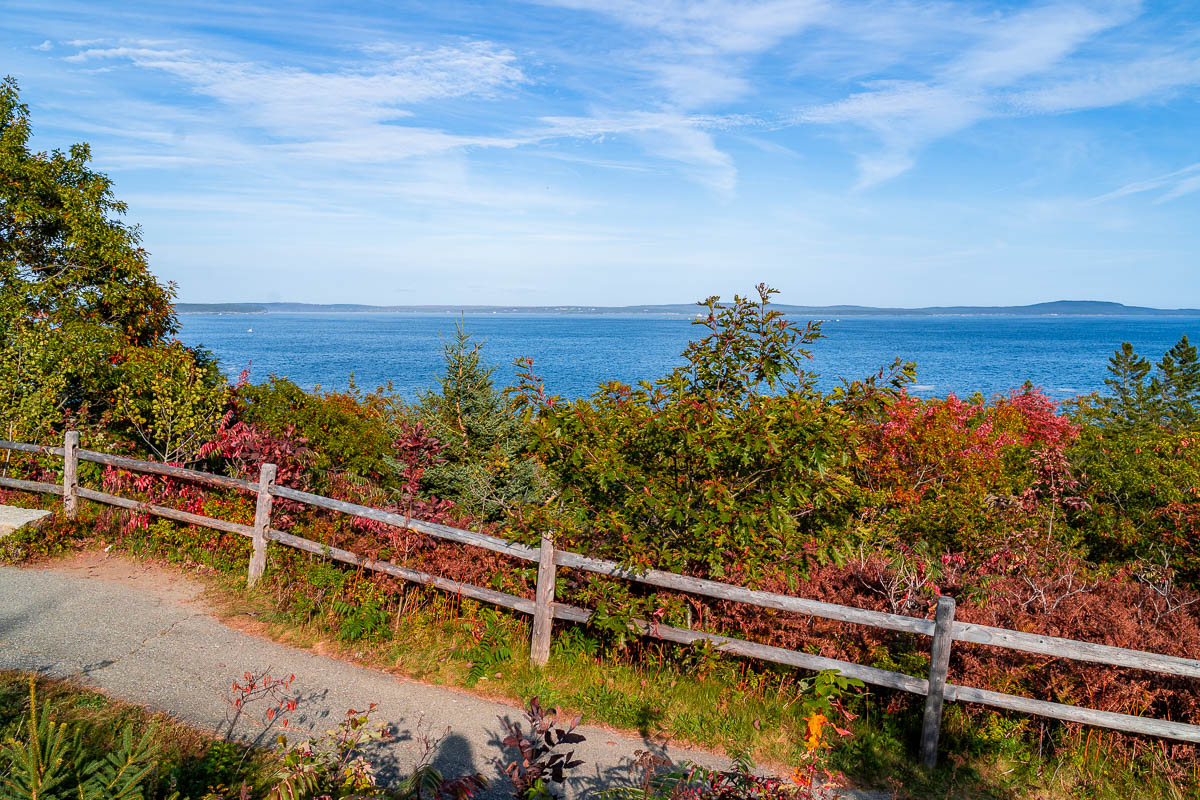
How to get around Acadia by bus
Acadia National Park offers a free shuttle bus service, the Island Explorer, from late June until Columbus Day in mid-October. The bus connects trails, campsites, hotels, and visitor centers around Mount Desert Island.
If your trip to Acadia falls before the middle of October, this service will take the pressure out of navigating the park and trying to track down parking spaces.
The drivers will also drop you off at locations aside from the designated stops, provided they can safely pull over. You can even bring your bike on board, as the bus can accommodate up to four bicycles.
How to get around Acadia by car
Many visitors choose to use a car to adventure around Acadia in the fall. Traveling by car means you can see much more of the park in a shorter period of time and is a popular choice for anyone hoping to drive the famous Park Loop Road, which is 27 miles (43.5 km) of mountains, coastline, and lakes.
While cruising around the park in a car is comfortable and convenient, it’s worth noting that parking can be an issue at busier times.
Remember to always keep your pass visible on your dashboard when you’re within the park boundaries.
For a small fee, you can even purchase a self-guided driving audio tour which makes the exploring even more interesting!
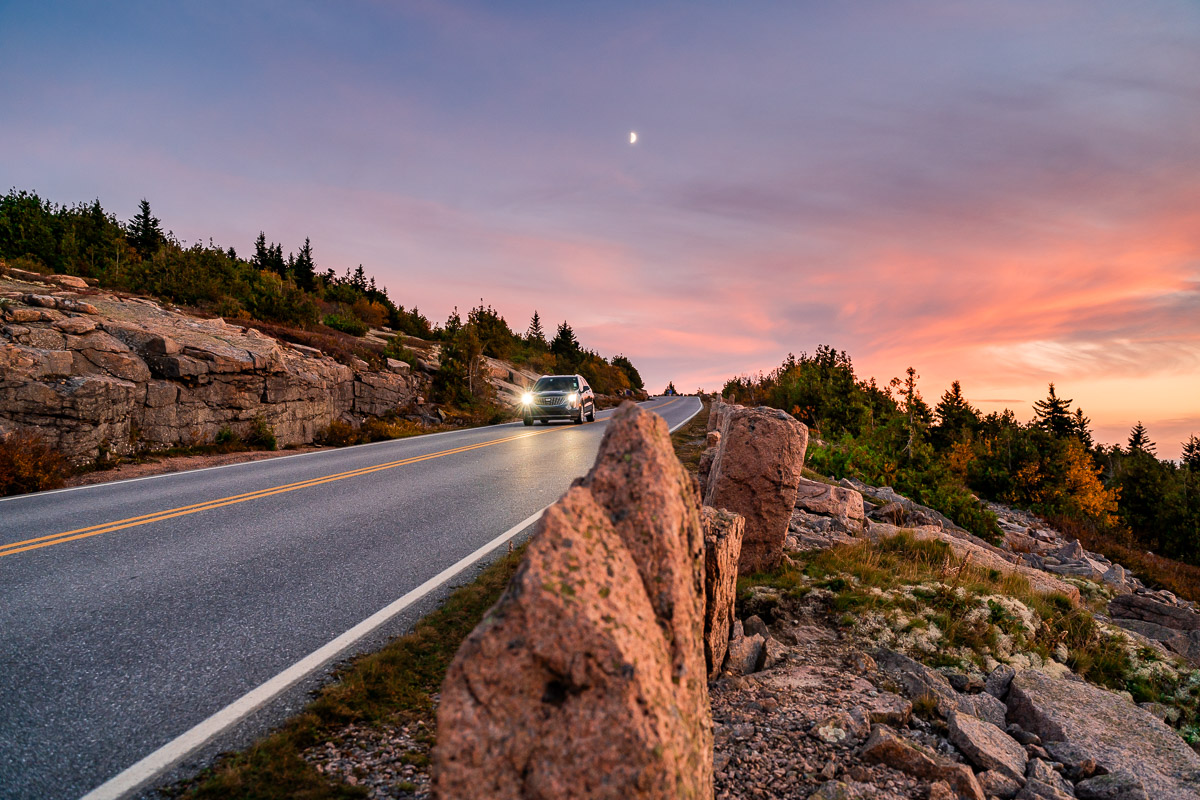
Where to Stay in Acadia National Park in the Fall
Best areas to stay in Acadia National Park
You’ll find plenty of places you can stay near Acadia National Park. Get in touch with nature and hit up one of the campsites on Mount Desert Island, or stay in a cozy hotel or B&B in the tourist hub of Bar Harbor.
Many nearby towns, like Ellsworth or Trenton, are less than a 30-minute drive away and worth researching to avail of cheaper accommodation rates.
As most people tend to stay a little closer to the park, let’s look at some of my favorite lodgings on Mount Desert Island for all budgets.
- Luxury: Bar Harbor Grand Hotel
- Mid-range: Best Western Acadia Park Inn
- Budget: Belle Isle Motel
Camping in Acadia National Park in the fall
Wild camping and overnight parking aren’t permitted, so if you plan to camp during your visit to Acadia National Park in the fall, be sure to be mindful of this. However, there are several official sites where you can set up camp.
It’s important to note that you must reserve your spot at whatever campsite you choose ahead of time via Recreation.gov or the campground’s website.
Grounds usually remain open until mid-October, so camping won’t be an option if you visit in late October.
- Blackwoods Campground: Ideal for anyone planning on driving the Park Loop Road, this site is on the east of Mount Desert Island and houses tents and motor homes for $30 a night.
- Seawall Campground: Located on the island’s western side, Seawall offers sites starting from $22 per night.
- Schoodic Woods Campground: One of the best campsites on Acadia’s mainland, Schoodic Woods is around an hour away from Bar Harbor. Prices range from $22 to $60 a night.
- Duck Harbor Campground: On the lesser-known Isle Au Haut, you’ll find a small campsite called Duck Harbor. Cars are prohibited on this island, as it’s rocky and untamed. As a result, this campsite only houses hikers who can set up their tents in one of the site’s shelters.
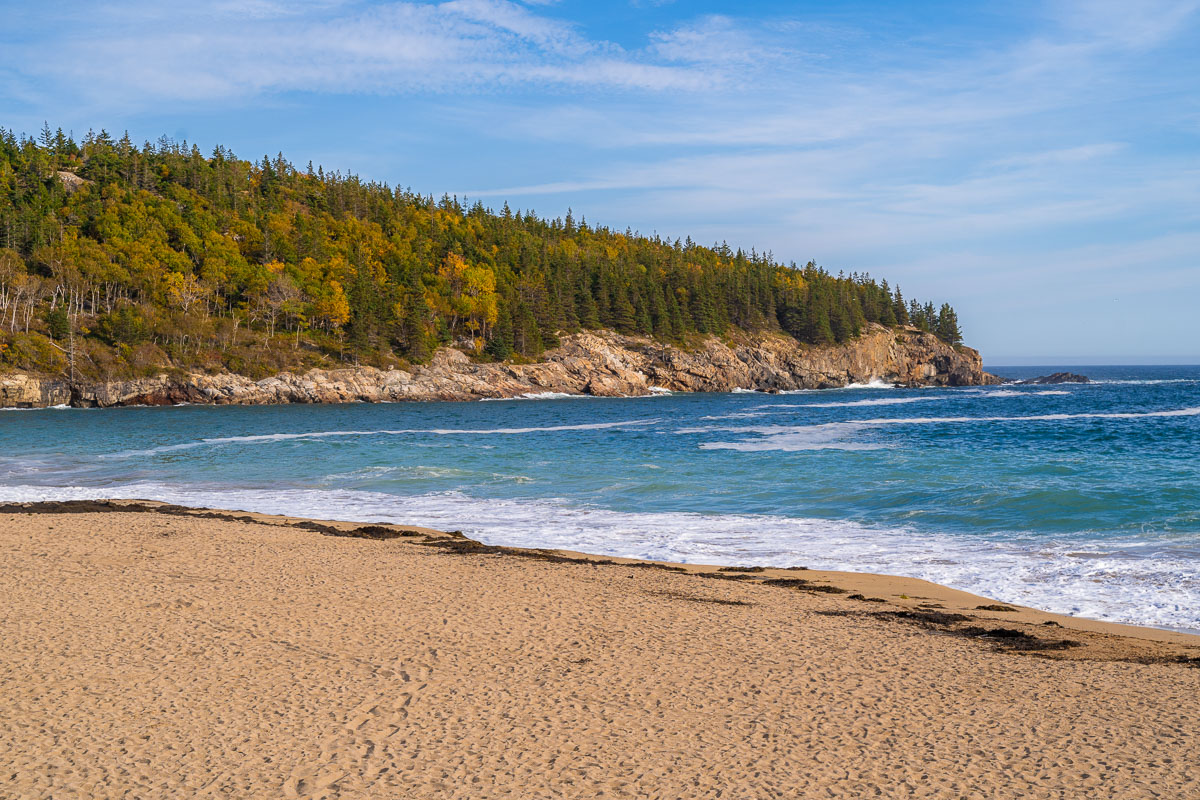
What’s the Weather Like in Acadia in the Fall?
September and October are both fantastic times to visit Acadia National Park, though the weather is, of course, different depending on which month you choose.
Almost like an extension of the summer, September starts with generally warm conditions and gradually becomes cooler towards the end of the month, with temperatures ranging from 48°F to 68°F.
However, the evenings can sometimes become nippy, September daytime temperatures are some of the nicest of the year, striking the perfect balance between hot and cold.
Another benefit of a September trip is that this is considered the clearest month of the year, meaning you can appreciate the best of views!
With an average of seven days of rainfall during the month, you’re much less likely to encounter any downpours in September than in October.
October sees the start of the chillier weather, going from lows of 37°F to highs of 55°F. You’ll need to wrap up, but the temperatures remain ideal for hiking, as you won’t need to worry about the heat tiring you out or the frost making an appearance.
While October in Acadia can’t offer quite the same level of visibility as September, skies are usually still quite clear, and the clouds shouldn’t interfere with the views for the most part.
Rain is expected in Acadia in October for about nine days of the month, with your chance of getting stuck in a shower increasing toward the latter half of October. The first few weeks of October are still regarded as falling within the drier months of the year.
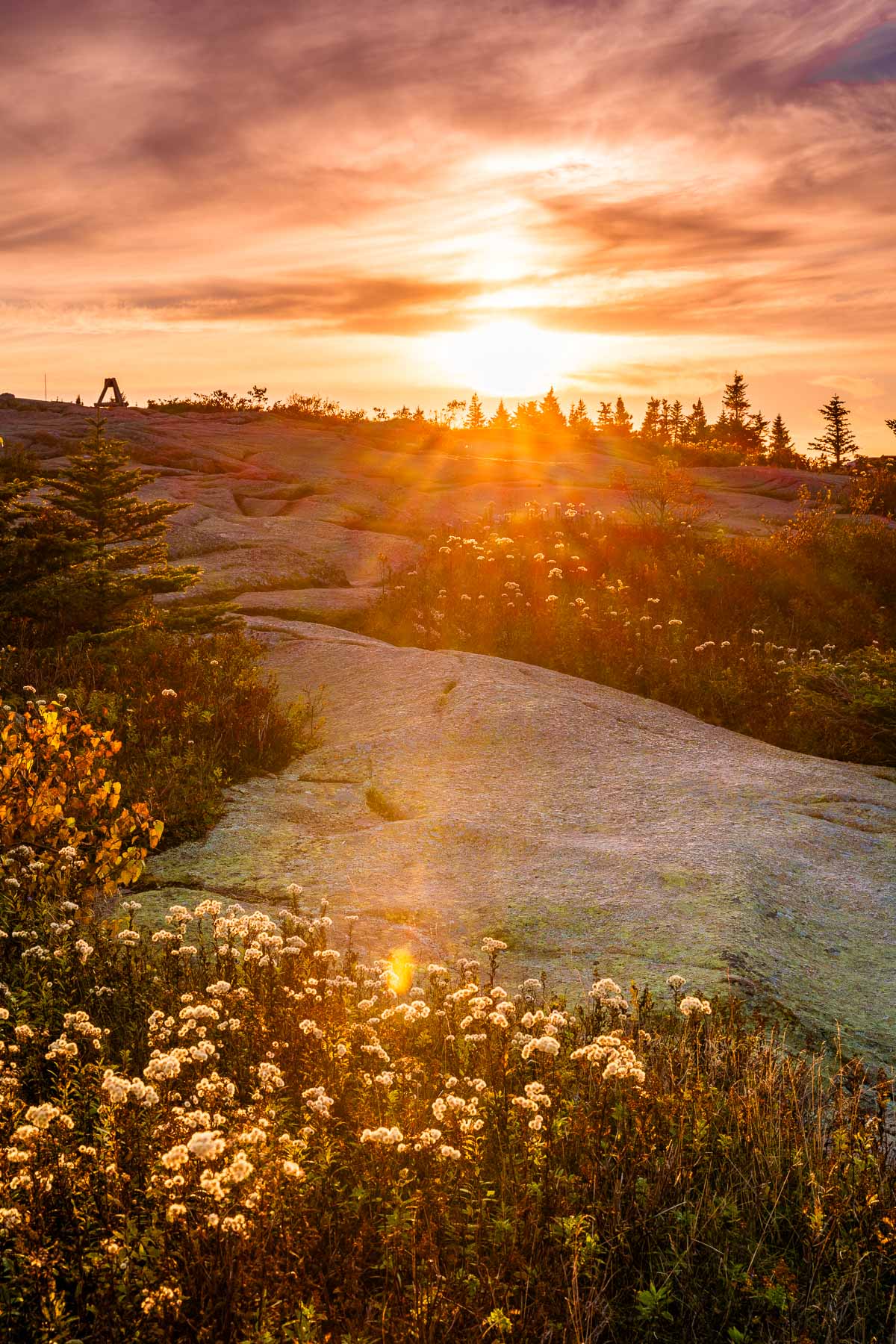
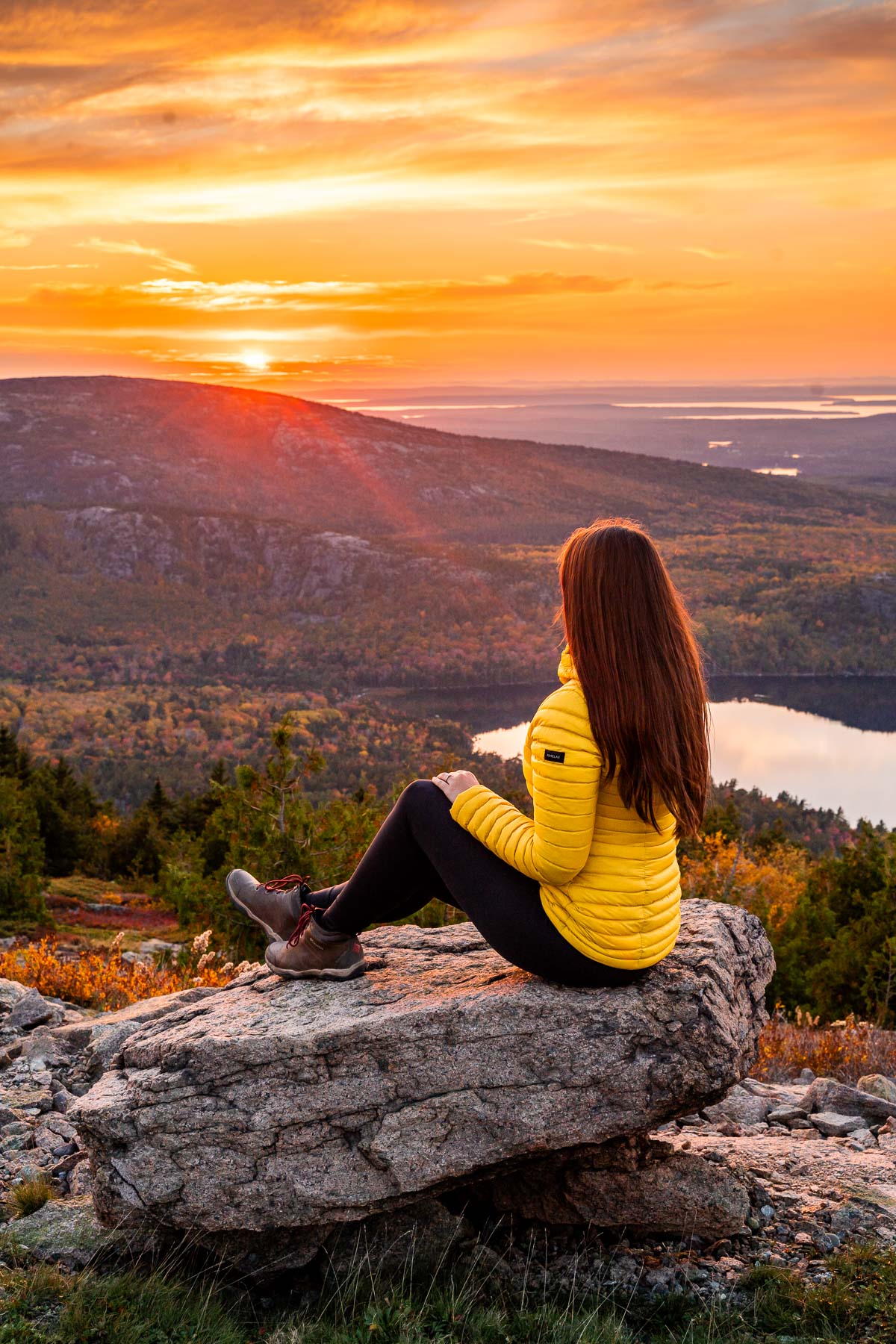
What to Pack for Chasing the Fall Colors in Acadia National Park
Last but certainly not least, your packing list! Determining what you need for a trip can be stressful, often leading us to bring much more than what we need.
This list will differ if you’re heading to one of the campsites, as it doesn’t include camping gear and cooking equipment.
First, let’s go through what attire you need to consider packing for a fall visit:
- A waterproof, warm jacket
- A lightweight rain jacket if your favorite cozy cost isn’t water resistant or for warmer days
- Long-sleeve t-shirts or thermals
- Hiking pants with zip-off legs
- A dress/shirt/trousers if you’re heading to a fancier restaurant or bar
- Light T-shirts (September)
- Thermal leggings (October)
- Hat, neck warmer, and gloves (October)
- Hiking boots or durable sneakers (the Columbia Newton Ridge Hiking Boots are my go-to boots for hiking)
- Comfortable socks (you can’t go wrong with these dri-tech socks)
- Swimsuit (optional)
Next, we’ll look at other additions to your suitcase that will come in handy:
- Day bag for all your hiking essentials (our favorites are the Peak Design Everyday Backpack and the Peak Design Everyday Totepack)
- Sunscreen (yes, even in the fall!)
- Headlamp or flashlight
- Well-stocked first-aid kit
- Compact travel umbrella
- Binoculars to get a better view
- Power bank
- Refillable water bottle
Best Things to Do in Acadia National Park in the Fall
Despite being smaller than many other national parks in the US, Acadia is definitely not short on things to do.
As expected, completing some of the park’s most gorgeous hikes will be high on pretty much every visitor’s list, and I’ll run through all the trails you shouldn’t miss during your trip, but did you know that you can even hit the beach or go on a walking tour on Mount Desert Island, too?
Here are my top suggestions for things to do in Acadia in the fall.
Marvel at Cadillac Mountain
Acadia’s highest peak is also the first place in the States where the sun rises during the colder months, starting from early October.
Perhaps the most popular attraction in the park, Cadillac Mountain can get extremely busy, especially at dawn, and it’s even more beautiful in September and October when the sun lights up the fall foliage.
You can either hike the trail to the top or purchase a Cadillac Mountain pass to drive up the famous summit road. If you arrive on a clear day, you’ll be treated to jaw-dropping views of the ocean, colorful landscapes, and surrounding islands.
Whichever option you choose, you absolutely have to include Cadillac Mountain on your Acadia National Park itinerary.
Important: If you’re visiting from the end of May to the end of October, vehicle reservations in advance are mandatory to access Cadillac Mountain Road. It costs $6 per vehicle, and you can reserve your spot on the official website.
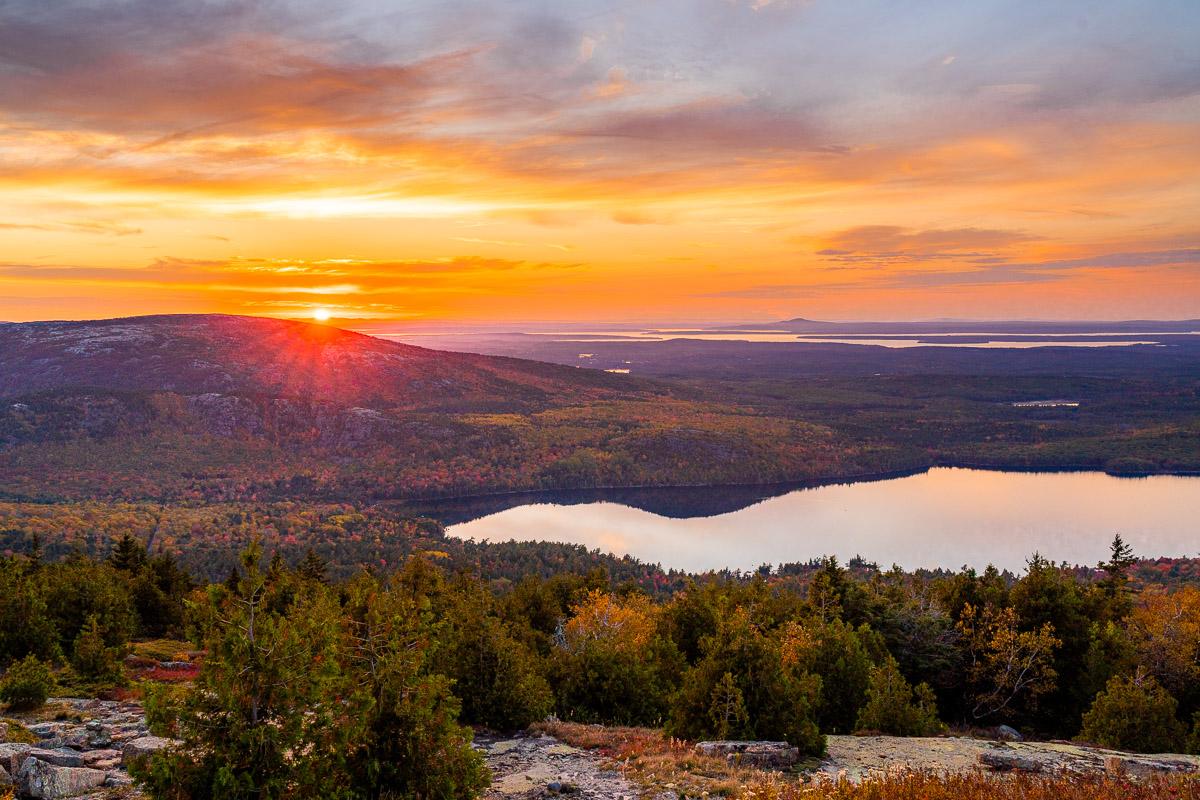
Road trip along the Park Road Loop
The Park Road Loop is a must if you plan to explore Acadia by car. You’ll follow a well-kept road for almost 30 miles (48 km) that passes by some of the park’s main points of interest and takes you by dense, colorful forests, serene lakes, and rocky mountains.
This is a great way to experience the beauty of the park if you’re short on time or aren’t up for hiking.
Along the way, you’ll pass the stunning Jordan Pond, witness the waves crash against the shore at Thunder Hole, and stroll down the quaint Sand Beach, but we’ll get more into these spots later.
Watch the sun go down at Bass Harbor Head Lighthouse
At the south of Mount Desert Island is the charming Bass Harbor Head Lighthouse.
As the only lighthouse on the island, this spot is becoming increasingly popular and a hotspot for visitors searching for the perfect place to watch the sunset. Dolphins and seals have even been spotted here!
For these reasons, the lighthouse tends to get crowded in the late afternoon, so ensure you give yourself plenty of time to find parking if you’re driving. Unfortunately, you can’t go inside, as it’s still actively used by the Coast Guard.
Stroll or swim at Sand Beach
A favorite stop of mine on the Park Road Loop, Sand Beach looks like a tropical paradise in the middle of imposing, vibrant trees, especially if you time your visit to see the best of Acadia National Park’s fall foliage.
Surprisingly, this is one of two beaches in Acadia, but it’s the most visited. Stretch your legs or rest up after a hike and amble along the shore, where you can even take a dip if you’re brave enough to swim in the notoriously cold waters. You’ve been warned!
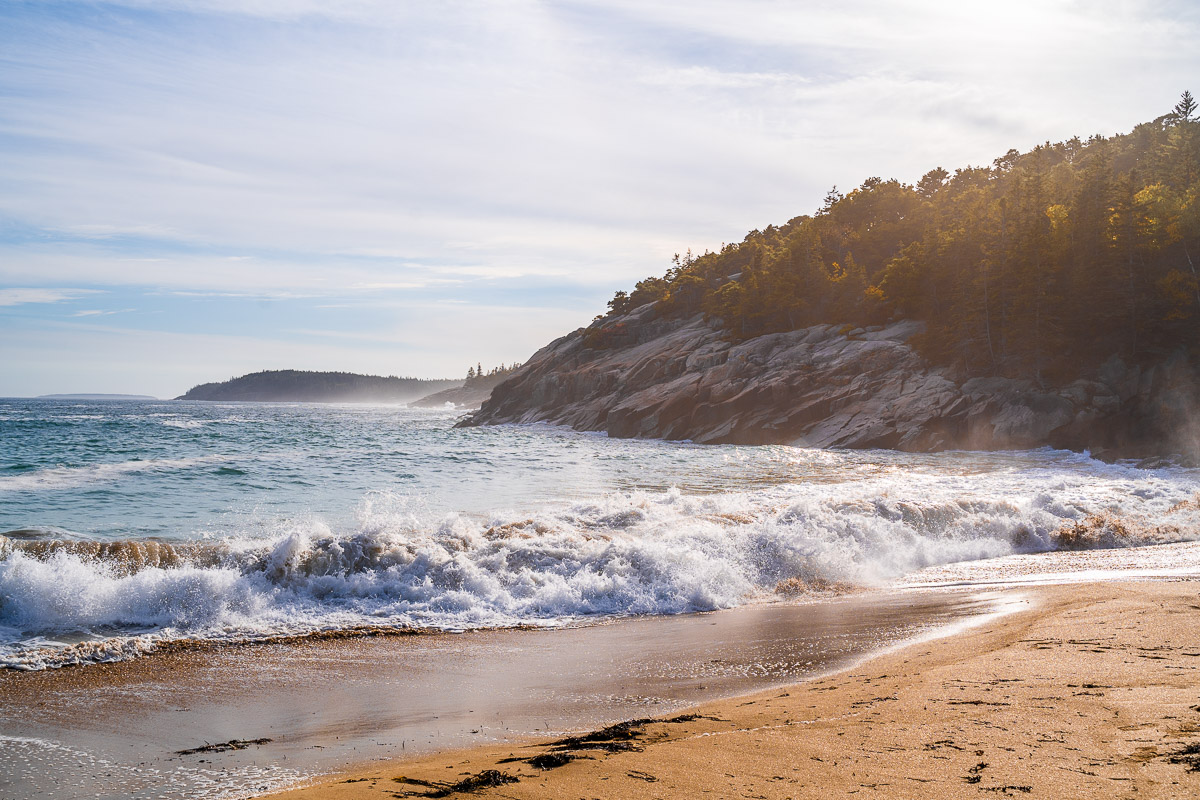
Admire the powerful Thunder Hole
Hopefully, this will be the only encounter with the sound of thunder during your visit to Acadia. This experience happens from time to time, thanks to the location of a partially underwater cave.
As tides rise, the waves loudly crash against the cave walls and create a sound resembling thunder as trapped air inside is released. Water sprays into the air as the waves crash, so it’s best to watch from the nearby viewpoint if you don’t want to get wet.
There’s no way to guarantee you’ll witness this fascinating act of nature, but your best chance is to arrive about 2 hours before the tide is due to rise, so ensure you keep tabs on the tide times.
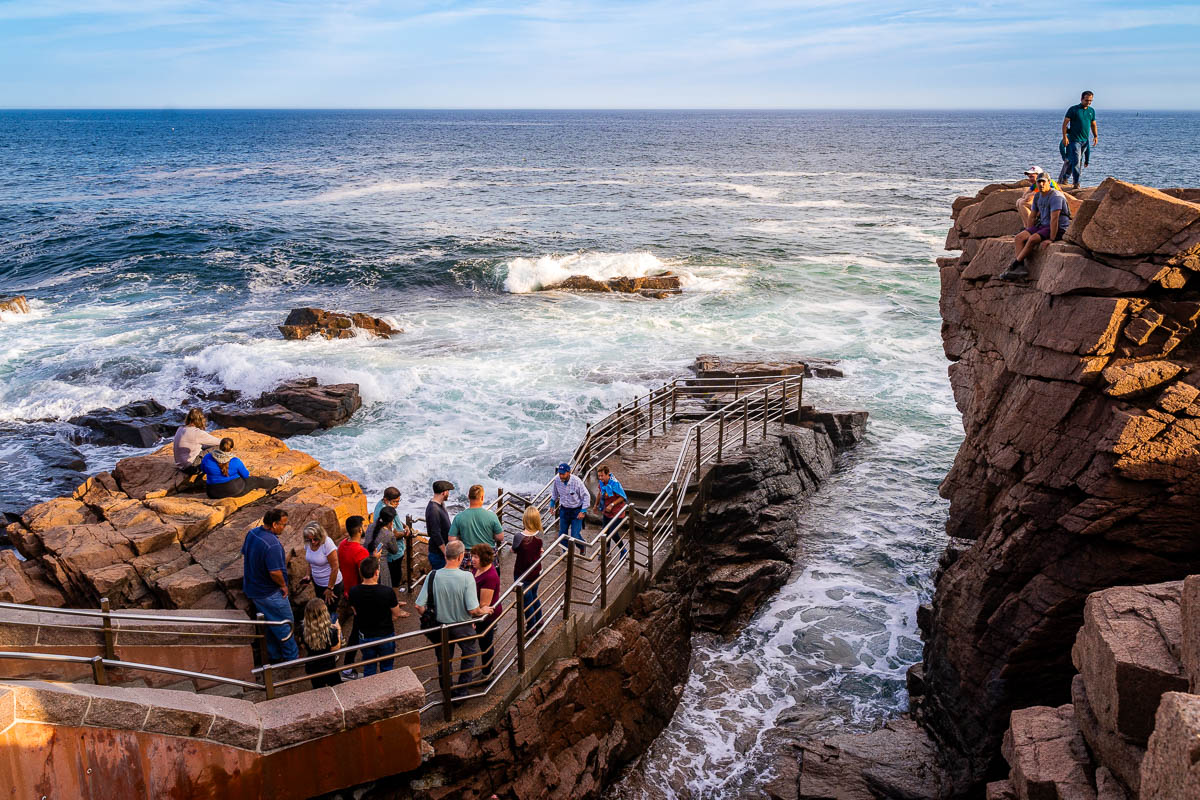
Join the Bar Harbor culinary walking tour
When you’ve spent a few days taking on the great outdoors, you might find yourself wanting to learn more about the history and culture of Bar Harbor.
What better way to experience the culture than by sampling some local culinary favorites on the Bar Harbor Culinary Walking Tour?
Over the course of 3 hours, your guide will fill you in on Bar Harbor’s past and take you on a foodie adventure, hopping between popular eateries in the town, enjoying everything from blueberry cakes and Italian sandwiches to balsamic vinegar and, of course, the town’s iconic lobster rolls.
Hike the Ocean Path
The first trek on this list, hiking along the Ocean Path from Sand Beach to Otter Point, is a pleasant stroll along the coast of Mount Desert Island.
An easy and much-loved trail, this is an ideal place to begin your fall trip to Acadia and is very much a family-friendly route. As long as you don’t get too close to the steep cliffs, this will be a laid-back and enjoyable hike.
Admire the fall foliage on the Jordan Pond loop
An amazing place to see the best of the fall foliage, the Jordan Pond is surrounded by thick, giant trees and is home to another easy and relaxed hike.
The loop around the lake is straightforward and continues for about 3 miles (4.8 km). Jordan Pond itself is a sight to see, so you may want to spend a little more time here to make the most of the views and unwind.
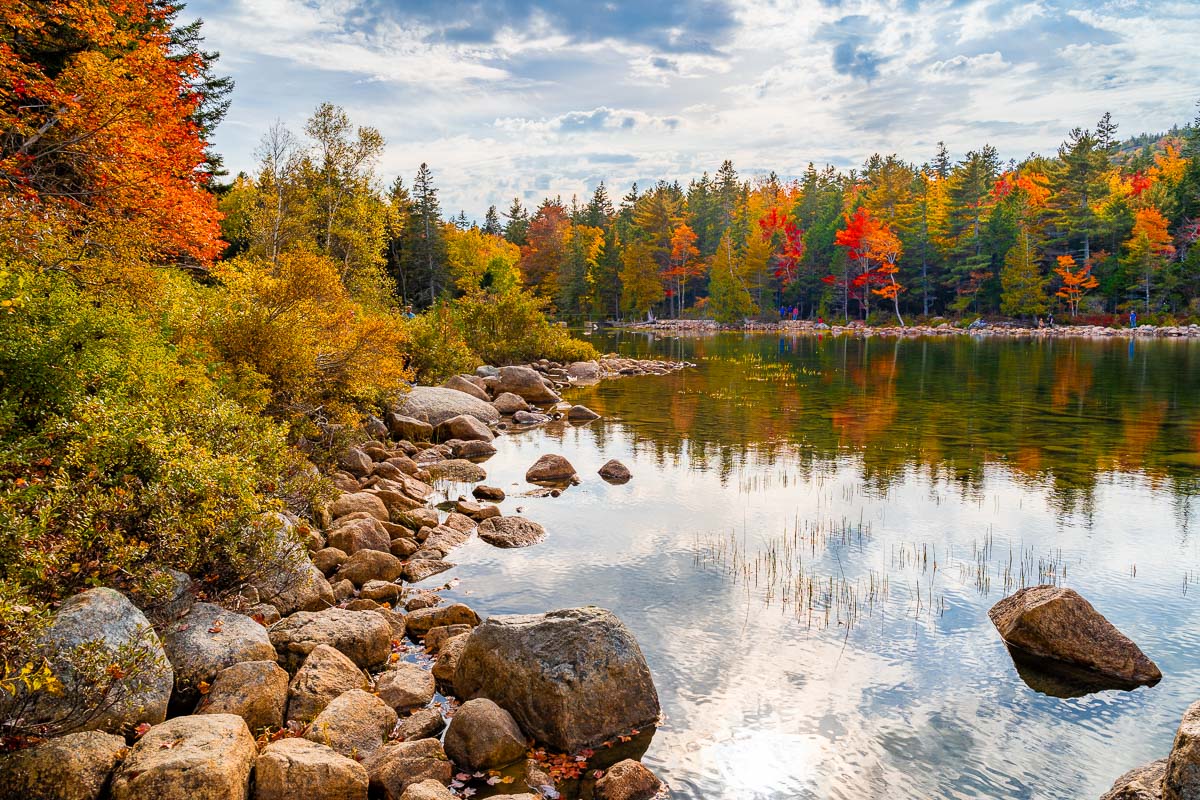
Check out the pond from above on the South Bubble trail
If a slightly more challenging hike with unparalleled views of the Jordan Pond sounds more like your style, the South Bubble Trail is for you.
You can begin at the pond and make your way to the top for a longer, moderate hike, or you can start from the Bubbles Divide, where you’ll see a parking lot that is just 30 minutes from the summit.
Go on an adventure on the Beehive loop
Moving onto a significantly more demanding hike that will reward you with some of the finest views you can imagine, the Beehive Trail is at the top of the agenda for adventure-seekers and eager hikers.
Though the loop is just 1.5 miles (2.4 km), you’ll be tasked with some steep ascents and sections that require you to climb rather than hike.
Once you reach the top, I promise it will totally be worth it, as you can soak up the unspoiled views of the Acadia coastline and many of the park’s highlights from above.
The journey down is less taxing, though young children should not attempt this trial, and the same goes for those with mobility difficulties or a fear of heights.
For anyone looking for even more of a thrill, the Precipice Trail is a dangerous and often terrifying hike that will satisfy any daredevil!
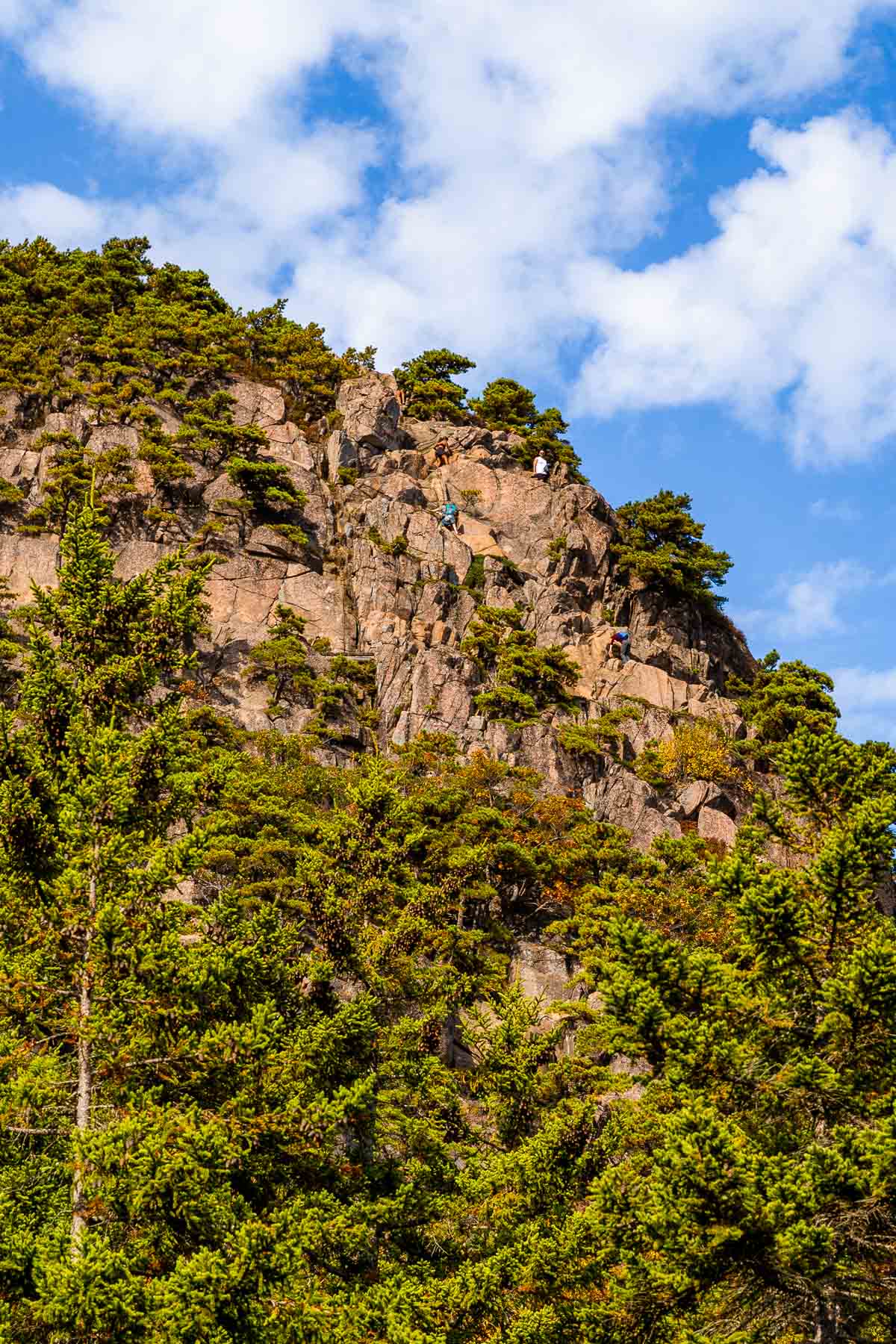

Where to Eat During Your Acadia National Park Fall Foliage Trip
A hugely important part of any trip, finding the best spots to curb your hunger can make any adventure even better.
Dining within Acadia National Park is mainly limited to the fabulous Jordan Pond Restaurant (or whatever you can cook up at one of the campsites), but Bar Harbor has an impressive roster of restaurants and cafes.
I have put together a selection of my favorite haunts in Bar Harbor for you to try for yourself.
- Side Street Cafe: Serving up Bar Harbor’s famous lobster rolls amongst classics like hearty sandwiches and fresh salads, this laid-back restaurant has something for all the family, so there’s no need to worry if you have any fussy eaters in your party!
- Havana: A more up-market eatery, Havana prepares high-quality, Latin American-inspired dishes and is best known for its seafood paella and oysters.
- Cafe This Way: Located just off Main Street in Bar Harbor, Cafe This Way is an artisan cafe that specializes in breakfasts and brunches. In addition to excellent coffee, the menu comprises sandwiches, burritos, eggs, pancakes, and beyond
- Jordan’s Breakfast: A long-standing breakfast favorite, Jordan’s menu consists of flavorful omelets, Belgian waffles, and French toast, but you absolutely can’t leave without trying their beloved wild blueberry pancakes.
- 2 Cats Bar Harbor: Another amazing option for breakfast and brunch that prepares bagels, French toast, pancakes, and nutritious homemade granola alongside bottomless coffee and freshly squeezed juices.
- Geddy’s: A perfect place to warm up with a bowl of steaming chowder, Geddy’s has heaps of delicious fish options, as well as pizza and beef burgers if you don’t fancy seafood.


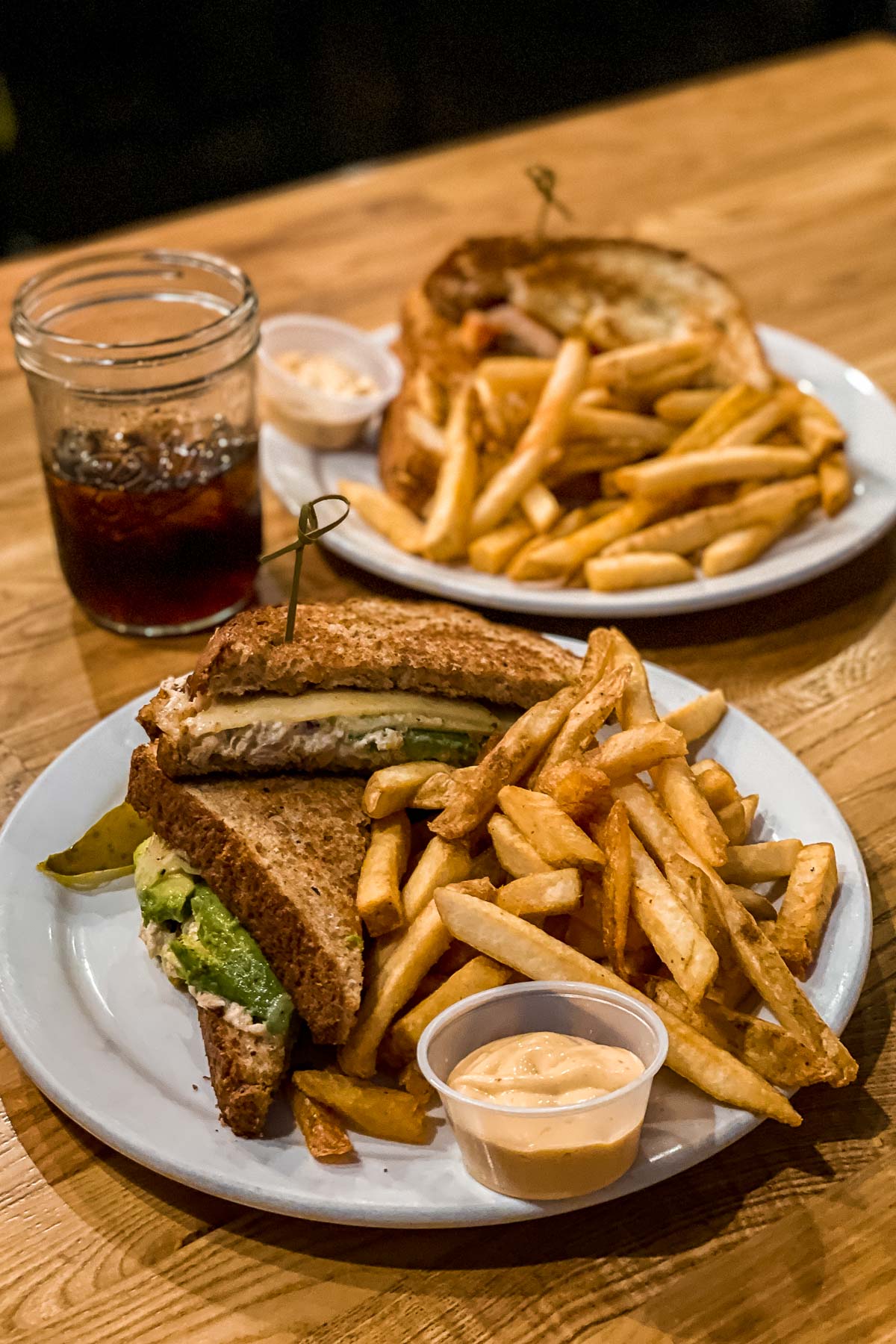
Practical Tips for Visiting Acadia National Park in the Fall
Acadia National Park in October, or September for that matter, is an unforgettable experience. To ensure your adventure goes as smoothly as possible, here are a few more top tips:
- Double-check that you have printed your entrance pass if you bought it online.
- Screenshot your Cadillac Mountain reservation if you plan to drive up, as you may not have a signal when you arrive at the park.
- Plan your activities beforehand to decide whether you’ll need a car or not (for what it’s worth, I do recommend having one!)
- Book your accommodation at least a month in advance, as lots of people flock here in October to see the fall foliage.
- Stick to the speed limit, and only drive if you feel confident enough.
- Download an offline map.
- Pets are allowed in the park but must be kept on a leash.
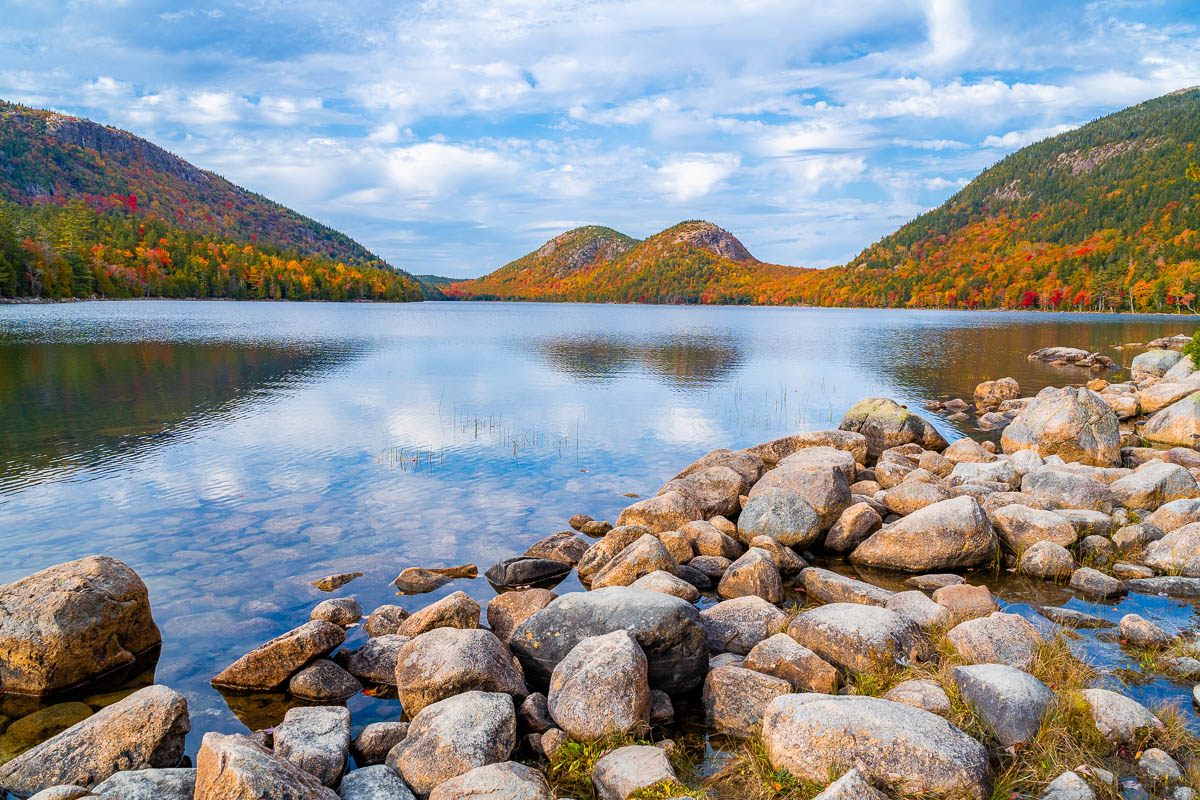
Planning a trip to New England?
Then you might want to take a look at all our other travel guides about New England. I promise, they are just as awesome as this article was!
Vermont:
- The Perfect New England Fall Road Trip for 2 Weeks
- Vermont in the Fall: Travel Tips & Best Places to Visit
- 16 Incredible Things to Do in Woodstock VT
- 17 Amazing Things to Do in Stowe, Vermont
- 17 Incredible Covered Bridges in Vermont You Need to Visit
New Hampshire:
Massachusetts:
- How to Spend One Day in Boston: Itinerary & Best Things to Do
- 13 Best Day Trips from Boston You Can’t Miss
- Where to Stay in Boston: 8 Best Areas & Hotels
- 19 Spooky Things to Do in Salem MA in October
Maine:
- How to Spend One Day in Acadia National Park
- The Perfect 2 Days in Acadia National Park Itinerary
- Acadia National Park in the Fall: Practical Info & Tips for Visiting
- How to Spend One Day in Portland, Maine
- 5 Prettiest Lighthouses in Portland Maine You Can’t Miss
Pin It for Later!
